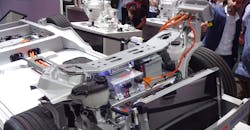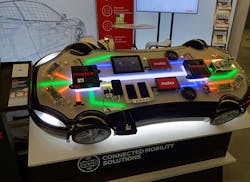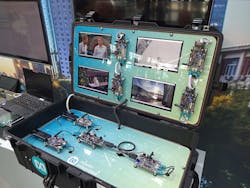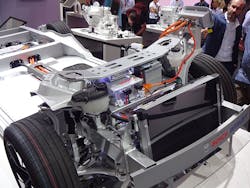Testing Next-Gen Automotive Wireless Systems
This article appeared in Evaluation Engineering and has been published here with permission.
Intelligent and connected electric vehicles (EVs) are becoming the most sophisticated mobile clients in the Internet of Things (Fig. 1). However, this confluence of various technologies also means that system designers are challenged with the task of proper system integration in an evolving and shifting technology and regulatory environment.
A Vehicle of Convergence
The demands placed on the manufacturer to integrate advanced features like interactive navigation and streaming multimedia require equally advanced testing solutions. This need for performance and compliance verification becomes even more critical in applications using personal information. This includes wireless card-free e-commerce to enable in-vehicle payment for goods and services, from gasoline and biofuel, to car washes and the hamburger drive-thru.
The explosion of RF-based vehicle systems is not just restricted to passenger-oriented functionality. The number of RF-based subsystems in a vehicle for features like tire pressure monitoring, remote keyless entry, software updates and car diagnostics need to be thoroughly tested at all stages of design, development, and manufacturing to ensure optimum results. Other next-generation in-vehicle systems include radar for advanced driver-assistance systems (ADAS), emergency response systems such as eCall, and backhaul for Wi-Fi mobile hotspot capability in the car (Fig. 2).
The growth of in-cabin systems places a greater pressure on the design team, as system integration is a critical issue. Video can be presented on transflective surfaces, dashboard or seat-back monitors, or wirelessly to handheld personal devices. Audio delivery could be via in-car speakers, headphone jacks in various locations, or via vehicle LAN. Each of these various sources require their own support infrastructures.
Security as a feature is becoming more and more of a reality, as consumers become more aware of the need for protecting their data and personal information. This need for security is also important for next-generation infotainment functionality like e-commerce, where credit card information and payment transactions must be protected. These transactions place demands on every aspect of the wireless connection, from stability to security.
In-Car Wireless
Wireless automotive subsystems are a recent but not new idea. Remote keyless entry (RKE) came from wireless car-alarm systems used mostly for convenience features like remote door operation and engine start. Another car application with some history is the tire pressure monitoring system (TPMS), mandatory for all new registered vehicles since November 2014. In addition, there are also wireless systems involved in car operation and emergency response such as ADAS and eCall automatic emergency calling.
The development of next-generation ADAS integrates a wide range of technologies, products, and services with the goal of helping drivers operate the vehicle in a safer and better manner, and will eventually migrate toward completely autonomous driving. Automotive radar technology is rapidly evolving as ADAS and Autonomous vehicle development drives demand for multiple, high resolution radars on each vehicle.
Today’s vehicles include up to 100 computing units and millions of lines of code. Keeping this system-on-wheels up to date, or installing new functions, used to require a trip to the repair shop. Since wireless internet connectivity enables services that don’t require physical presence, more and more solutions will be created that will require software or firmware updates over the air (SOTA/ FOTA). Such over-the-air solutions are currently used to optimize vehicles without turning a wrench, and make new or improved functionality available without a visit to a garage.
Today’s updates now can include targeted marketing and sales information, and in the future could incorporate augmented-reality data for heads-up displays and interactive passenger windows. In addition to updating vehicle software, car diagnostics and maintenance alerts can also be managed over-the-air. Next-generation smart vehicles will have cable jacks for diagnostics primarily as a backup, as most vehicle diagnostic and maintenance data will be cloud-enabled.
Intelligent Transportation
The place where this all comes together is called Intelligent Transportation. Part of a smart-city philosophy, Intelligent Transportation systems will provide innovative services involving all of the different modes of transport and traffic management. Such systems will also eventually include pedestrian devices and other nonvehicular telemetry involved with traffic and the movement of people.
This multilayered communication system with vehicles and the world around them is called vehicle-to-everything, or V2X. The V2X space is further broken down into vehicle-to-grid, vehicle-to-vehicle, vehicle-to-infrastructure, vehicle-to-pedestrian, and vehicle-to-network (Fig. 3). For example, once pedestrian cell phones become part of V2P, a person’s location can be confirmed by more than just spatial recognition sensing.
In the V2X space, dedicated short-range communication (DSRC) technology and the 802.11p standard have advanced to solve short-term needs. This is the first wave of mainstream V2X deployment, and complements developing LTE and 5G solutions. DSRC enables highly secure, high-speed direct communication between vehicles and the surrounding infrastructure, without involving any cellular infrastructure. IEEE 802.11p is an amendment to the IEEE 802.11 standard that defines enhancements to support Intelligent Transportation Systems (ITS) applications.
Key challenges and opportunities in high mobility communication systems testing include the accurate modeling of high mobility channels, the transceiver structures that can exploit the properties of high mobility environments, the signal processing techniques that can harvest the benefits, such as Doppler diversity, and mitigate impairments such as carrier frequency offset, intercarrier interference, and channel estimation errors.
Evaluating Automotive Systems
A methodical ground-up approach is necessary to ensure that the vehicle, its RF subsystems, and passenger devices are working together in harmony. One approach is to begin with the car’s internal wireless provision capabilities, then evaluate the WLAN products and subsystems involved, evaluate connection issues, then explore any interference and noise issues.
A good first step is to determine if you are receiving a WLAN signal everywhere in the vehicle. By collecting RF test data under demanding operating conditions, you can quantify real-world cabin wireless characteristics. Ensuring high-quality and stable in-vehicle services requires both performance data for communications modules, and quantitative data from the finished products.
Once you have determined the ability of the vehicle to support a wireless environment, it is useful to validate the receiver and transmitter characteristics of the vehicle’s wireless devices and systems. The error vector magnitude, or EVM, is an index expressing the difference between theoretical and actual symbol points as a percentage. A product with poor modulation accuracy does not receive signals correctly, and the communications speed may decrease with more dropped connections.
Tx characteristics may also be degraded due to the positioning of the internal antennas when the product orientation is changed, suffering changing modulation accuracy as the product orientation changes. That is another reason it is very important to use testing situations as realistic as possible, to also reflect these critical but subtle issues.
In addition, the modulation accuracy can change significantly when changing the transmission rate and modulation method in the device. In the image across the bottom of the slide, it shows that some products are able to operate stably at all transmission rates, but others suffer changing modulation accuracy when the transmission rate changes.
Changing the equipment channel and frequency is another aspect that sharply affects modulation accuracy, due to the frequency characteristics performance. The modulation accuracy of some products is stable even when the channel is changed, but other products suffer changes in modulation accuracy with channel changes. Properly done, effective simulation and testing of RF transmit and receive performance will result in better product performance, enhanced reliability, and increased energy efficiency.
Interference and Noise
Interference hunting requires the ability to spot, find and fix a known interferer, which is not always an easy task. Not only having the right tools, but the ability to properly identify the issue is key to interference hunting. Unwanted signals include illegal transmissions, unlocked and drifting transmissions, noise from leaky cable TV feeds, unsuppressed EMI from power tools or microwave ovens, local high-power radios, and even multipath from nearby buildings and hills. Interference from both illegal and unintentional signals is a significant problem, degrading network performance and interrupting communications.
Internal radio interference (Intra-EMC) from different components inside a product, such as the power supply, CPU and motor, can be one cause of increasing customer complaints about poor product performance. In other words, WLAN Tx and Rx performance can be degraded in finished products. Noise from devices such as power supply inverters, motors in cooling fans, and other agents cause faults in WLAN communications as a form of IntraEMC (intra-electromagnetic compatibility).
Although the frequency of the motor noise may be lower than the frequency bands used by wireless LAN at 2.4/5 GHz, receiver sensitivity performance is degraded, and errors occur even when the receive signal is sufficiently strong. With this type of intra-EMC, the various noise frequencies generated within the finished product itself will adversely affect its wireless LAN communications capabilities.
The growing number of USB ports in a vehicle create yet another area of potential noise-interference problems in the 2.4-GHz band. The USB 3.2 Gen-one standard enables high-speed communication speeds to reach 5 Gb/s, with a digital transmission reference frequency of 2.5 GHz. This can radiate as interference noise in the 2.4-GHz band, unless the device has the appropriate design, compliance evaluation, and leakage countermeasures implementation.
Solving these serious noise issues generally requires the characterization of the noise source by using a measurement probe and spectrum analyzer, addition of filters, and shielding. Noise mitigation may even require extreme measures like a board respin and changes to the parts layout to cut the noise to an acceptable level. So, the best way to improve communications quality is by performance and compliance evaluation.
Safety and Security
Created to speed first-responder mobilization, eCall is an emergency rescue information system for cars that automatically transmit traffic accident information, including accident location, to an emergency assistance center, or Public Safety Answering Point, or PSAP. In addition to deploying in Europe, the eCall system will also be deployed in ASEAN member countries of Asia. The regulation applies to passenger vehicles with driver and eight or less seats, and trucks up to 3.5 tons maximum load weight.
eCall is activated automatically as soon as the in-vehicle system’s sensors detect a life-threatening crash, triggering it to dial the European emergency number 112, establishing a telephone link to the appropriate emergency call center. The system uses the European-based Galileo satellite positioning network, and European Geostationary Navigation Overlay Service (EGNOS). ERA-GLONASS, the Russian automated emergency response system, and EU's eCall have similar functionality, and are forming a common road safety space throughout Russia and EU member states.
Since eCall calling uses cellular mobile networks, complex evaluation with the various changing parameters and network signal strength is required. For example, when a traffic accident occurs during communication using LTE, the IVS must issue using packet data communication immediately before the accident. eCall operates over GSM or W-CDMA, by switching the wireless communications network using the CS Fallback function.
Looking Forward
The passenger car’s role as a rolling IT environment will only continue to grow, and the burden lies on the electronic design community to integrate and deploy the latest technologies and solutions. The role of the automobile in society is radically changing, due to the empowerment of cloud-based functionality. This electronics development demands the best processes and tools to ensure all devices and systems involved operate alone and together at an optimum level.
About the Author
Alix Paultre's Archive
Editor-at-Large
Also check out Alix's main author page for his latest articles.
An Army veteran, Alix Paultre was a signals intelligence soldier on the East/West German border in the early ‘80s, and eventually wound up helping launch and run a publication on consumer electronics for the US military stationed in Europe. Alix first began in this industry in 1998 at Electronic Products magazine, and since then has worked for a variety of publications in the embedded electronic engineering space. Alix currently lives in Wiesbaden, Germany.
Also check out hjis YouTube watch-collecting channel, Talking Timepieces.




